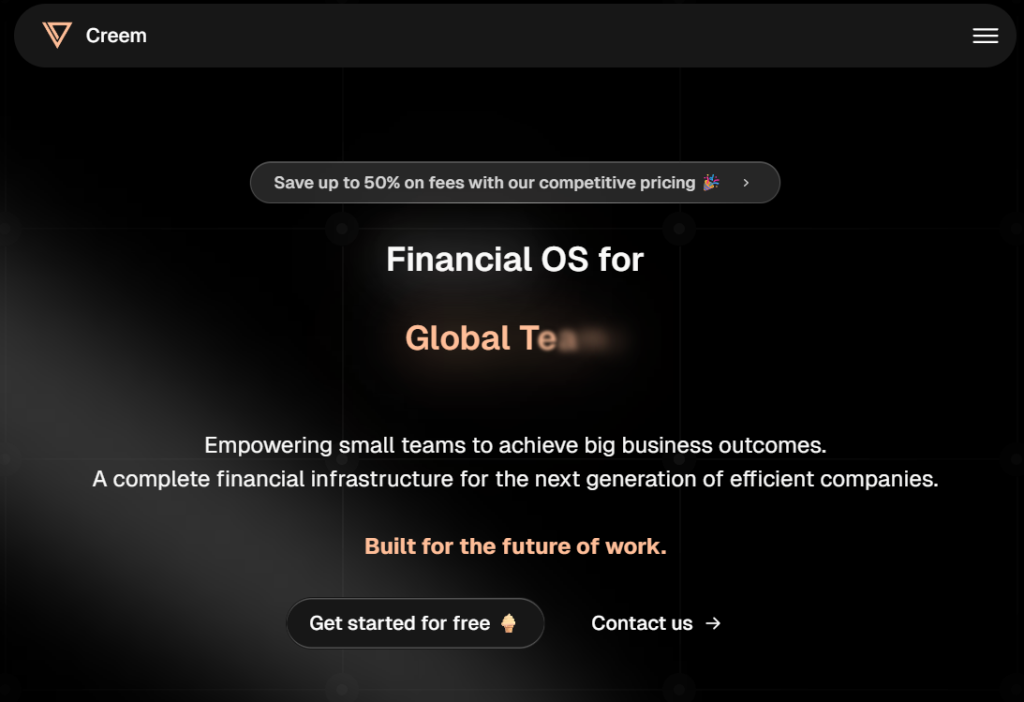Creem Raises $2.1M Pre-Seed to Power Embedded Finance for SaaS Innovators
September 24, 2025
byFenoms Start-Ups

Creem has secured $2.1 million in pre-seed funding, backing its mission to help SaaS companies unlock new revenue streams with integrated embedded finance. The round was led by Practica Capital, signaling investor confidence in platforms that blur the line between software and financial services.
Founded by Gabriel Ferraz, a fintech entrepreneur with roots in crypto and software innovation, Creem is building financial rails specifically designed for indie hackers, micro SaaS operators, and agile teams. By offering Merchant of Record (MoR) and Payment services tailored for this community, Creem enables companies to scale globally without drowning in the complexities of compliance, tax, and payments infrastructure.
Why Embedded Finance Needed Disruption
For decades, software companies and SaaS founders faced a dilemma: innovate quickly or spend precious resources on payment compliance, tax localization, and transaction complexity. Merchant of Record platforms existed, but they were often designed for large enterprises with sprawling finance teams.
For indie hackers, micro SaaS projects, and lean startup teams, this gap has been painful. Payment failures, inconsistent revenue recognition, and tax headaches often stunted growth or forced companies to pivot prematurely.
Creem flips this dynamic by providing a purpose-built MoR and embedded finance layer. With Creem:
- SaaS teams can launch globally without first building complex financial infrastructure.
- Founders can offload compliance and tax handling, freeing energy for product innovation.
- Payments become a growth accelerator instead of a drag on resources.
This move democratizes embedded finance, shifting power toward smaller, more agile innovators who often move faster than enterprise incumbents.
The Founder’s Perspective: From Crypto to SaaS
Creem’s CEO Gabriel Ferraz didn’t follow a conventional path. Leaving computer science studies early, he plunged into crypto during its formative years. That led to building Brazil’s first crypto-focused development agency and later ventures in Forex, commodities, and fintech.
Now, Ferraz sees SaaS and AI colliding with indie hacking movements to reshape software. “Modern tools are letting smaller, agile teams ship products faster than ever before,” he explains. “But payments and compliance remain stuck in an enterprise-first model. Creem is designed to level the playing field.”
Ferraz’s engineering mindset - combined with fintech scars earned in volatile markets - equips him to tackle SaaS finance with both pragmatism and vision.
Strategic Insight for Founders
Here’s where Creem’s approach carries a powerful lesson for other founders: growth often accelerates when you stop trying to reinvent infrastructure. Too many SaaS startups waste cycles cobbling together payment processors, tax calculators, and cross-border compliance frameworks.
By leaning on Creem’s ready-to-go backbone, startups can:
- Cut time-to-revenue by 6–9 months.
- Expand into multiple regions without separate tax setups.
- Focus entirely on product-market fit and customer acquisition.
The insight is straightforward but underleveraged: don’t compete on plumbing. Compete on the product. When you free engineering teams from back-office burdens, you redirect velocity to what actually moves the needle - user growth and retention.
For founders in early stages, this tradeoff can be existential. A startup that launches six months faster is not just “ahead” - it’s playing an entirely different game of compounding adoption.
Investors Backing Creem
Creem’s pre-seed raise was led by Practica Capital (Vilnius, Lithuania), a venture capital firm with a history of backing bold fintech and SaaS infrastructure bets. Practica’s involvement signals not just financial support, but also strategic alignment: both share conviction that fintech infrastructure will unlock the next wave of SaaS innovation.
This partnership is designed to give Creem more than capital - it provides credibility, market access, and a launchpad into Europe’s broader fintech ecosystem.
Market Outlook: SaaS and Embedded Finance Converge
The timing of Creem’s raise is strategic. The global embedded finance market is projected to reach $7.2 trillion in transaction value by 2030 (McKinsey), driven by SaaS platforms embedding payments, lending, and financial services directly into workflows.
Meanwhile, the SaaS industry itself is on track to surpass $1 trillion by 2032, with micro SaaS and indie hacking models contributing to the sector’s diversification. According to NASSCOM, SaaS exports from emerging hubs like India and Eastern Europe are expected to grow 30–40% annually.
But here’s the kicker: compliance and payment barriers remain the single biggest friction point for small SaaS teams. A recent Stripe study found that 42% of SaaS founders cite cross-border tax and payments as their top scaling hurdle.
Creem sits at the heart of this problem. By reframing finance as an accelerator instead of an obstacle, it doesn’t just ease pain - it redefines how SaaS teams think about going global.
What’s Next for Creem
With fresh capital, Creem plans to:
- Expand engineering teams in Tallinn and beyond.
- Deepen partnerships with SaaS platforms and micro SaaS communities.
- Broaden global coverage for payments and compliance services.
The mission is ambitious but clear: empower SaaS founders to move faster by removing finance as a bottleneck.
As indie hacking and micro SaaS continue reshaping software’s future, Creem is building the rails that will let these innovators scale sustainably. In an era where agility beats size, that could prove transformational.









